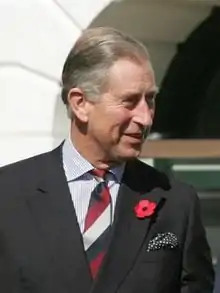David Kang
David Kang (born 1970) is an Australian barrister. In 1994, he fired two blank shots of a starting pistol at Charles, Prince of Wales in protest at the treatment of several hundred Cambodian asylum seekers held in detention camps in Australia.[1]
David Kang | |
|---|---|
| Born | 1970 (age 50–51) |
| Education | Macquarie University (BA) University of Technology Sydney (MBA) University of Sydney (LLB) |
| Known for | Firing two blank shots of a starting pistol at Charles, Prince of Wales |
| Children | 2 |
Early life and education
David Kang was born in Australia to Robert Kang, a former Republic of Korea Air Force helicopter pilot.[2] At the time of the starting pistol incident, in 1994, Kang was an anthropology student at Macquarie University. Kang later graduated with a Bachelor of Arts degree in anthropology from the university.[2]
Prince of Wales starting pistol incident

On 26 January 1994, the 23-year old Kang fired two blank shots from a starting pistol at Charles, Prince of Wales, during an Australia Day speech at Tumbalong Park, Darling Harbour in Sydney.[3]
Kang jumped a small fence at the front of the stage and ran onto the stage, firing the first shot with his pistol as he rushed towards the Prince, who had just risen to approach the lectern on the stage. He was wrestled to the ground by police after crashing into the lectern as he fired the second shot. At least 15 people jumped onto the assailant, while another man shielded the Prince, who was removed from the stage.[3] The Prince sustained no injuries[3][4] and would next visit Sydney on 28 February 2005.[2][5]
One police officer received a cut hand while tackling Kang. Local police expressed admiration for the speed with which the Prince's Senior Personal Protection Officer, Superintendent Colin Trimming, rose to protect the Prince of Wales.[6] The personal bravery of the Prince was also remarked upon by Ian Kiernan, saying that the prince was "cool as a cucumber".[3]
Others on the stage included Rear Admiral Peter Sinclair, AO (the Governor of New South Wales), John Fahey (the Premier of New South Wales), Frank Sartor (the Lord Mayor of Sydney), and Tony Lauer (the New South Wales Commissioner of Police).[7]
Kang had been the second person to attack a royal in Sydney, after Irishman Henry James O'Farrell. O'Farrell shot at Prince Alfred and was later hanged.[8] At the time, Kang was mistakenly reported as being of Cambodian descent, and the incident sparked some debate about monarchism and republicanism in Australia.[9]
Arrest, trial, and sentence
Kang was arrested and taken to Sydney Police Centre on Goulburn Street. On the following day, he appeared in court and, facing six charges, including two under the Federal Crimes (Internationally Protected Persons) Act 1976 (Cth) (i.e., attacking an internationally protected person) and charges of illegally using a firearm, possessing a firearm, affray, and assault, was remanded in custody until 4 February 1994. If convicted on all counts, Kang could have received a 20-year sentence.[2][3]
In court, Kang testified that he was suffering from depression and was protesting the plight of Cambodian refugees in Australia.[2] Kang had previously written letters to the Prince of Wales, the President of the United States, the United Nations, and the Pope, among others, and had received a form letter reply from the Prince.[8]
Kang was found guilty of threatening unlawful violence and sentenced to 500 hours of community service.[2]
11 years after the event, Kang said of the incident, "What happened 11 years ago was an extremely traumatic experience and I have certainly moved on in my life and now I have become a barrister here in Sydney" and "I have certainly moved on in my life. But I didn't have any intention to hurt anyone".[10]
Career
Following the incident, Kang earned a Master of Business Administration from the University of Technology Sydney and a Bachelor of Laws with honours from the Sydney Law School.[2][11]
Legal career
Despite having been found guilty of a crime, the New South Wales Bar Association found that Kang was a "fit and proper person", with the president of the New South Wales Bar Association remarking that he had "served his time",[12] admitting him as a barrister in 2004.[11] Kang practises as a barrister, specialising in criminal law, commercial and corporations law, equity, and medical negligence,[13] at Ada Evans Chambers in Sydney.[11]
Personal life
Kang is married with two children. His interests, as listed on his chambers website, include tennis, soccer, and swimming.[10]
References
- Newman, John (12 May 1994). "Cambodian Refugees". New South Wales Legislative Assembly Hansard. Parliament of New South Wales. Archived from the original on 29 September 2007.
- Benns, Matthew (6 February 2005). "He shot at a prince, now he's a barrister". The Sun-Herald. Fairfax Media.
- "Student fires 2 blanks at Prince Charles". Los Angeles Times. 27 January 1994.
- Johnson, Angella (27 January 1994). "Student faces six charges after starting-gun incident". The Guardian. London.
- "Charles' Australia tour under way". BBC News. 1 March 2005.
- Boggan, Steve (27 January 1994). "Threat to Charles: Bodyguards' four-second delay was 'total failure':". The Independent.
- (27 January 1994.) "Prince Charles keep his cool under fire", Sun Journal.
- Whittaker, Mark. "Time capsule: January 26, 1994". The Australian. 26 January 2008.
- Milliken, Robert (30 January 1994). "Role of Charles for interim King of Oz? It is not simply through his coolness in the face of Kang's assault that the Prince of Wales has made an impact in Australia". The Independent. London.
- Benns, Matthew (6 February 2005). "Man who shot at Prince Charles becomes barrister". The Age. Melbourne: Fairfax Media.
- Find a Barrister at New South Wales Bar Association: David Kang
- "Bar Association dismisses concerns Prince shooter now a lawyer". ABC News. Australian Broadcasting Corporation. 6 February 2005.
- Ada Evans Chambers: David Kang